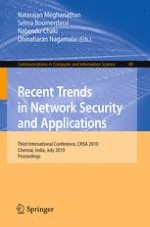The Third International Conference on Network Security and Applications (CNSA-2010) focused on all technical and practical aspects of security and its applications for wired and wireless networks. The goal of this conference is to bring together researchers and practitioners from academia and industry to focus on understanding modern security threats and countermeasures, and establishing new collaborations in these areas. Authors are invited to contribute to the conference by submitting articles that illustrate research results, projects, survey work and industrial experiences describing significant advances in the areas of security and its applications, including: • Network and Wireless Network Security • Mobile, Ad Hoc and Sensor Network Security • Peer-to-Peer Network Security • Database and System Security • Intrusion Detection and Prevention • Internet Security, and Applications Security and Network Management • E-mail Security, Spam, Phishing, E-mail Fraud • Virus, Worms, Trojon Protection • Security Threats and Countermeasures (DDoS, MiM, Session Hijacking, Replay attack etc. ) • Ubiquitous Computing Security • Web 2. 0 Security • Cryptographic Protocols • Performance Evaluations of Protocols and Security Application There were 182 submissions to the conference and the Program Committee selected 63 papers for publication. The book is organized as a collection of papers from the First International Workshop on Trust Management in P2P Systems (IWTMP2PS 2010), the First International Workshop on Database Management Systems (DMS- 2010), and the First International Workshop on Mobile, Wireless and Networks Security (MWNS-2010).
